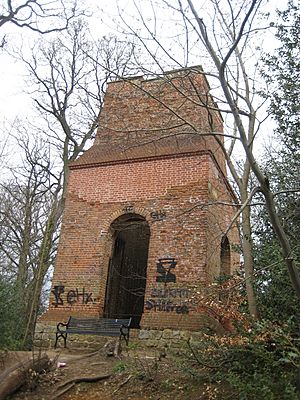Camberley Obelisk facts for kids
Quick facts for kids Camberley Obelisk |
|
|---|---|

View of Camberley Obelisk from the west, 2012
|
|
| Type | Tower |
| OS grid reference | SU 87915 60869 |
| Built | 1765–1770 |
|
Listed Building – Grade II
|
|
| Official name: Remains of obelisk in grounds of St Tarcissius School | |
| Designated | 19 July 1984 |
| Reference no. | 1377520 |
| Lua error in Module:Location_map at line 420: attempt to index field 'wikibase' (a nil value). | |
The Camberley Obelisk is a tall brick tower located on a hill in Camberley, Surrey, England. It is also known as Norris's Obelisk or Norris's Whim. A wealthy man named John Norris built it around 1765–1770. Part of the tower was destroyed by fire in the 1880s. Today, it is a Grade II listed building, which means it's an important historic structure.
Contents
What is the Camberley Obelisk?
Even though it's called an obelisk, this structure is actually a square tower. It is made of red bricks and has a stone base. You can find it on top of a wooded hill in Camberley Park. This is about 200 meters east of Camberley town centre.
The tower used to be much taller. It had several floors and was about 30 meters high. However, the top part was taken down in the late 1800s. Now, it is only about 9 meters tall. Its walls are very thick, up to 1.5 meters. There was once a wooden staircase inside to reach the top. Today, the inside is empty. All entrances are blocked off with iron grids for safety.
History of the Camberley Obelisk
This interesting tower was built by John Norris between 1765 and 1770. John Norris was a rich merchant and a member of the landed gentry. This means he owned a lot of land and property. He had homes in places like Hawley and Hughenden Manor in High Wycombe. The tower sits on a hill about 3 kilometers east of his house in Hawley.
When the tower was built, the town of Camberley did not exist. The area was open heathland. The hill where the tower stands overlooks the A30 road. This road was a busy turnpike road between Exeter and London in the 1700s. The tower was the only big building around. It became a well-known landmark for travelers for many years.
In 1801, the land around the tower became private property. John Norris's son, also named John Norris, traded some farmland to keep the land around the tower.
Later, in 1812, the Royal Military College was built nearby. A new town called Cambridge Town grew up close to the tower. This town later became Camberley. During the 1800s, students from the military college would climb the hill to the tower. This was part of their map-making exercises. You can still see their names and drawings carved into the bricks inside and outside the tower.
By the late 1800s, the tower was part of a large house's garden. This house was later a private girls' school. Around 1880, a campfire set by some travelers accidentally set fire to the wooden staircase inside the tower. This made the tower unsafe. In 1882, the owner of the house had the top part of the tower removed to make it safe again.
Over time, trees grew tall around the hill. This hid the tower from view. In 2000, Camberley Park was created. The tower was then opened to the public again.
Why Was the Obelisk Built?
No one knows for sure why John Norris built this tower. There are many ideas about its purpose. Some people think it was a watchtower to spot highwaymen on the road. Others believe it was a beacon to guide travelers across the heath. It might have been a platform for watching foxhunts. Some even think it was a signalling tower. Another idea is that it was simply a folly, a building built just for fun or decoration, with no real purpose.
The most popular idea is that Norris used the tower to send signals. He might have been signalling to his friend, Sir Francis Dashwood. Dashwood lived in West Wycombe, about 34 kilometers north of Norris's tower. In 1751, Dashwood had built a large, hollow golden ball on top of St Lawrence's Church in West Wycombe. This ball was 2.4 meters wide and had seats inside.
People believe that Norris and Dashwood signalled each other from the tops of their towers. They might have used flags or heliographs. Heliographs are devices that use mirrors to reflect sunlight and send messages. Some stories say Norris's tower also had a golden ball on top, like Dashwood's, but early pictures don't show this.
People have wondered why these two friends needed to signal each other. Some think they were signalling bets. Others suggest it was related to a secret club they were both members of. There's even a theory that they were part of a spy network. During the American War of Independence, Norris was thought to have sent secret information to Dashwood. Dashwood was the Postmaster General at the time. A letter from Norris in 1778 mentions: "Did this day heliograph intelligence from Dr Franklin in Paris to Wycombe." This adds to the mystery!
Images for kids
-
The Obelisk, painted by John Hassell in 1812




